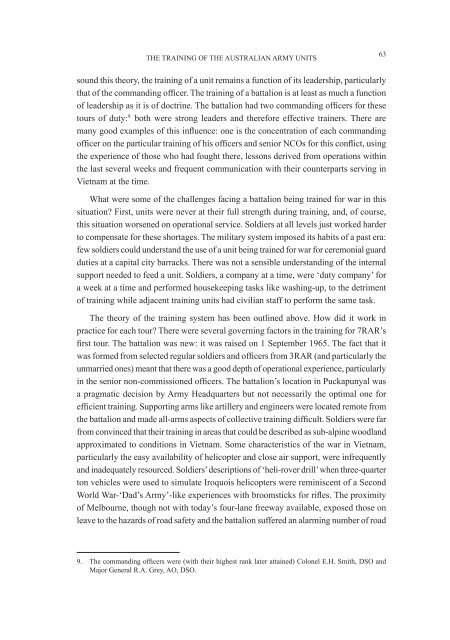conference proceedings - Australian Army
conference proceedings - Australian Army
conference proceedings - Australian Army
You also want an ePaper? Increase the reach of your titles
YUMPU automatically turns print PDFs into web optimized ePapers that Google loves.
The TrAInIng oF The AusTrAlIAn <strong>Army</strong> unITs<br />
sound this theory, the training of a unit remains a function of its leadership, particularly<br />
that of the commanding officer. The training of a battalion is at least as much a function<br />
of leadership as it is of doctrine. The battalion had two commanding officers for these<br />
tours of duty: 9 both were strong leaders and therefore effective trainers. There are<br />
many good examples of this influence: one is the concentration of each commanding<br />
officer on the particular training of his officers and senior nCos for this conflict, using<br />
the experience of those who had fought there, lessons derived from operations within<br />
the last several weeks and frequent communication with their counterparts serving in<br />
Vietnam at the time.<br />
What were some of the challenges facing a battalion being trained for war in this<br />
situation? First, units were never at their full strength during training, and, of course,<br />
this situation worsened on operational service. Soldiers at all levels just worked harder<br />
to compensate for these shortages. The military system imposed its habits of a past era:<br />
few soldiers could understand the use of a unit being trained for war for ceremonial guard<br />
duties at a capital city barracks. There was not a sensible understanding of the internal<br />
support needed to feed a unit. Soldiers, a company at a time, were ‘duty company’ for<br />
a week at a time and performed housekeeping tasks like washing-up, to the detriment<br />
of training while adjacent training units had civilian staff to perform the same task.<br />
The theory of the training system has been outlined above. How did it work in<br />
practice for each tour? There were several governing factors in the training for 7RAR’s<br />
first tour. The battalion was new: it was raised on 1 september 1965. The fact that it<br />
was formed from selected regular soldiers and officers from 3rAr (and particularly the<br />
unmarried ones) meant that there was a good depth of operational experience, particularly<br />
in the senior non-commissioned officers. The battalion’s location in Puckapunyal was<br />
a pragmatic decision by <strong>Army</strong> Headquarters but not necessarily the optimal one for<br />
efficient training. supporting arms like artillery and engineers were located remote from<br />
the battalion and made all-arms aspects of collective training difficult. soldiers were far<br />
from convinced that their training in areas that could be described as sub-alpine woodland<br />
approximated to conditions in Vietnam. Some characteristics of the war in Vietnam,<br />
particularly the easy availability of helicopter and close air support, were infrequently<br />
and inadequately resourced. Soldiers’ descriptions of ‘heli-rover drill’ when three-quarter<br />
ton vehicles were used to simulate Iroquois helicopters were reminiscent of a Second<br />
World War-‘Dad’s <strong>Army</strong>’-like experiences with broomsticks for rifles. The proximity<br />
of Melbourne, though not with today’s four-lane freeway available, exposed those on<br />
leave to the hazards of road safety and the battalion suffered an alarming number of road<br />
9. The commanding officers were (with their highest rank later attained) Colonel e.h. smith, Dso and<br />
Major General R.A. Grey, AO, DSO.<br />
63

















